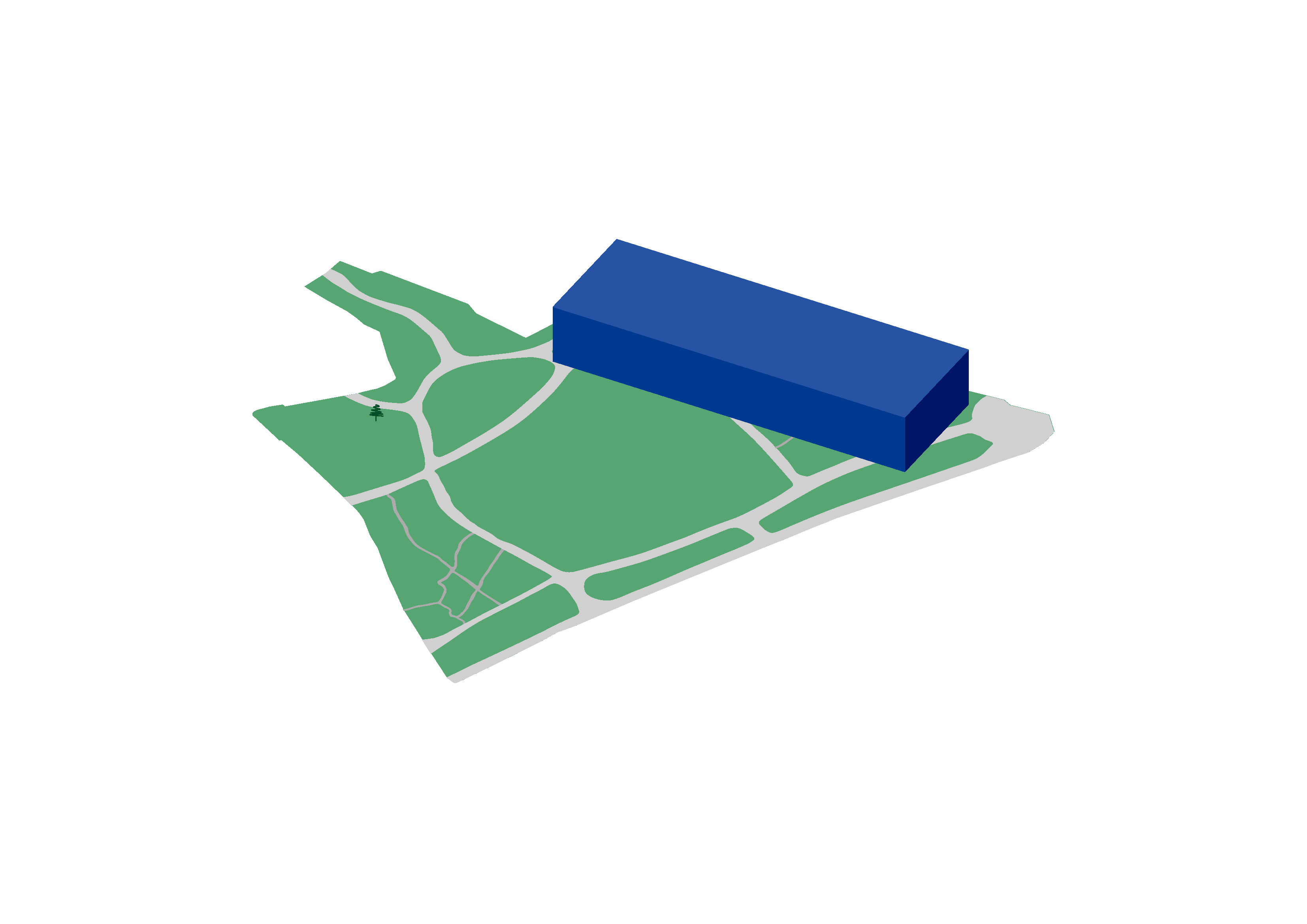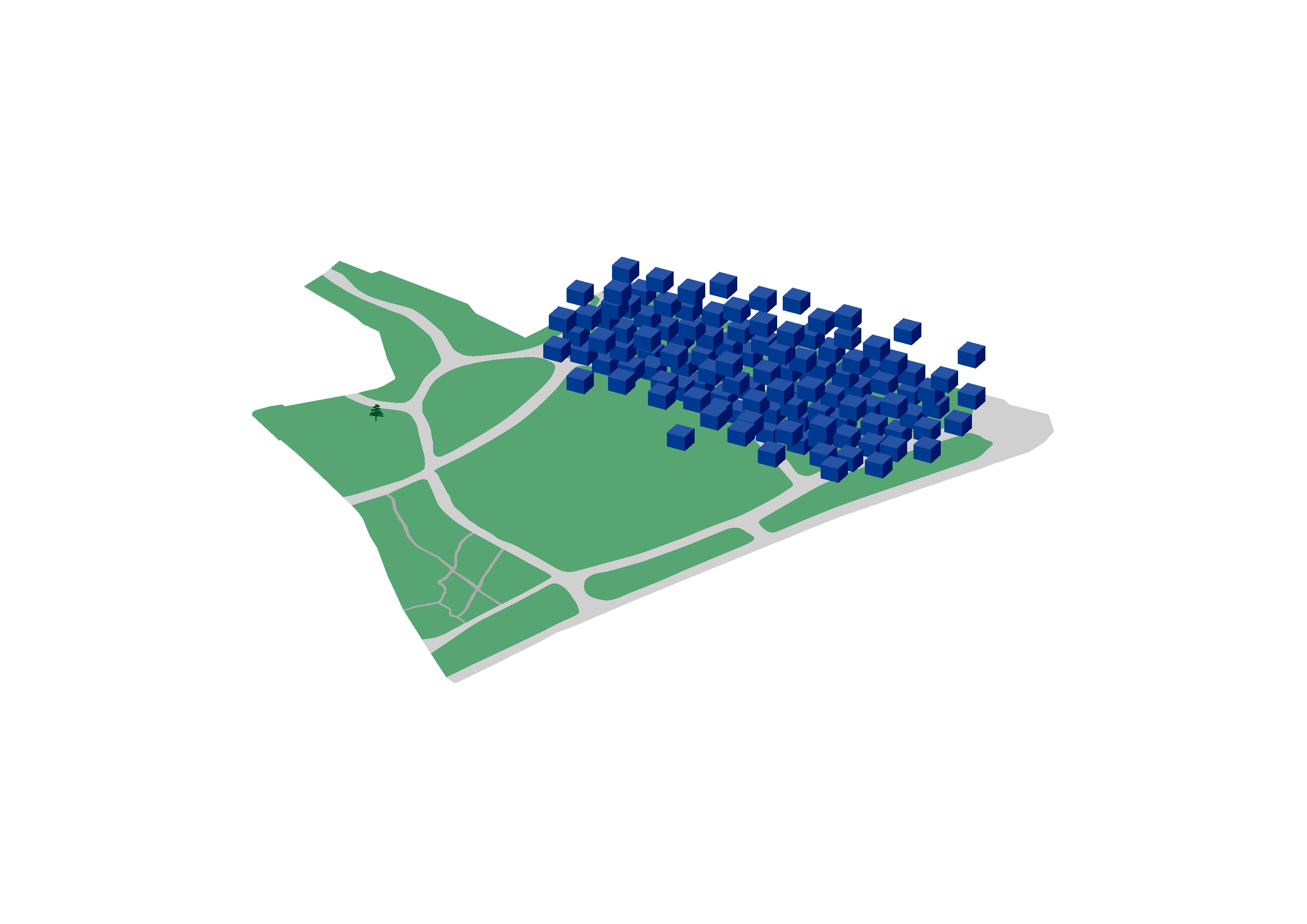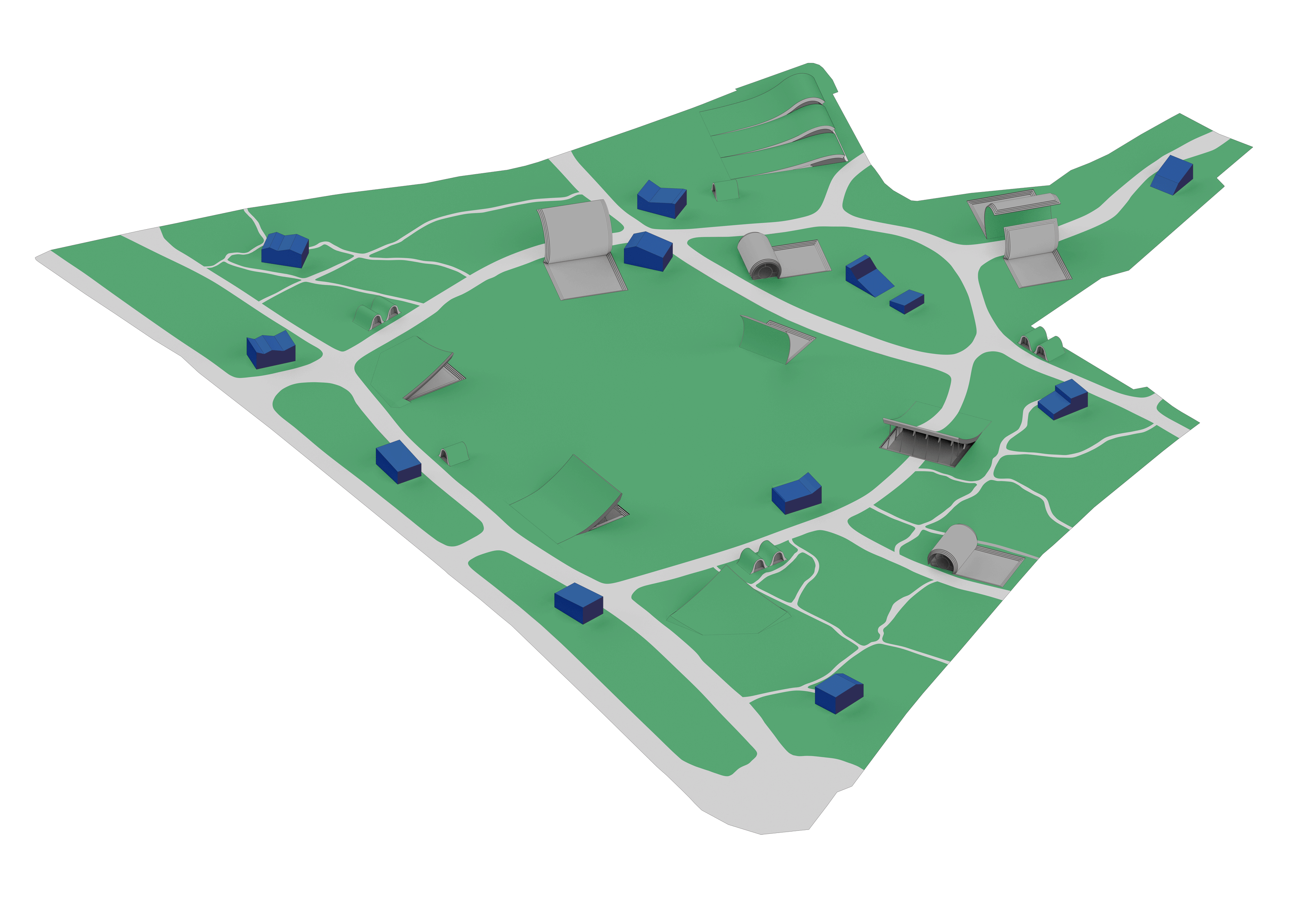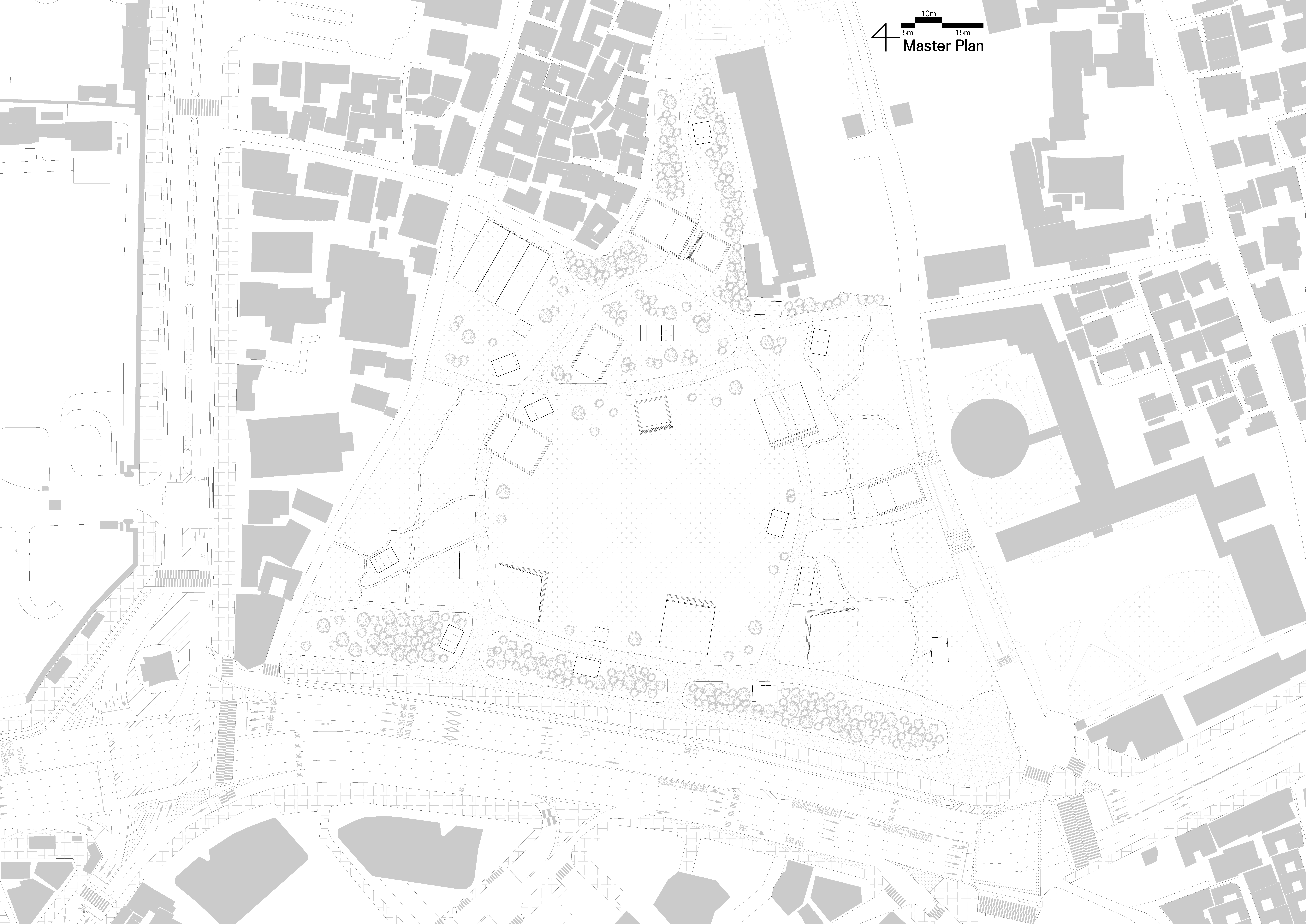김범석
Beomseok Kim
La Vita Dispersa
열린송현 녹지광장은 최근에서야 시민들에게 개방된 땅으로 잘 알려져 있다. 경복궁 옆 소나무 언덕이던 이곳은 구한말부터 왕실, 일제, 미군, 재벌이 차례로 소유하였고, 그로 인해 110년 간 금단의 땅으로 불렸다. 현재 이곳에 이건희 기증관(가제) 건립이 2027년에 예정되어 설계공모가 진행중이다. 이건희 기증관(가제) 설계공모 기본계획에서는 바닥면적을 대지면적의 1/4, 연면적은 그의 3배로, 한 덩어리의 융합형 미술관을 계획하고 있다. 나머지 대지면적은 송현문화공원으로 조성할 계획이다. 하지만 구체적인 진행 내용은 대중에게 공개하지 않고 있다.
열린송현 녹지광장은 착공년인 2025년까지 시민 공모로 선정된 다양한 행사가 예정되어 있으며 이를 위한 넓고 평평한 녹지와 길 그리고 약간의 벤치와 나무만이 존재한다. 사대문 내부에는 넓은 녹지가 없기 때문에 대중들은 복잡한 도심 속 이곳이 계속 비워져 있기를 바라고 있다. 이와 더불어 미술계에서는 2세대에 걸쳐 다양하게 수집된 이건희 컬렉션을 다양한 미술관, 박물관으로 분산배치를 해야한다고 주장하고 있다. 하지만 국가는 이에 반하는 입장을 보이고 있는데, 이는 주변에 박물관, 미술관, 유적 등 관광지가 집중 분포되어있기에, 이들의 가치를 상승시키기 위해 국가는 대중들에게 정보공개를 하지 않은 채 이건희 기증관 건립을 추진하고 있는 것처럼 보인다.
이건희 기증관(가제) 기본계획처럼 일반적으로 박물관과 미술관은 소장품의 보안, 항온항습 설비, 관람자의 전시동선 등을 이유로 하나의 덩어리로 존재한다. 그리고 이 덩어리는 공원이나 광장 같은 공지의 변두리나 한가운데에 있어, 멀리서 입구까지 걸어가야 한다. 내부 공간은 거대한 로비와 선형적인 전시실의 구조로, 소장품을 부각시키기위한 특유의 전시실 인테리어 그리고 서사적이고 현학적인 전시 체계를 통해 외부와 동떨어진 상황을 연출한다. 다시 말해 박물관이 덩어리로 보이는 먼 거리에서부터 1층 로비를 지나 전시실로 가기까지의 진입 동선에서 관람자들은 비일상적인 분위기를 경험한다.
과거 부르주아지나 재벌들이 이름을 남기거나 권력을 표출하기 위해, 모아둔 컬렉션을 대저택에 보관, 대중들에게 개방하거나 박물관이나 공공미술관에 기부하는 행보를 보였다. 개인이 깃든 공간에서 이런 시퀀스의 경험은 박물관이나 미술관을 그들의 묘비로 인식하게 하는 기제가 된다. 이를 의식해서인지 최근 해외 사례에서는 기증자의 이름을 딴 기증실의 사례가 많다. 이런 맥락에서 개인의 컬렉션 기부를 문화예술적 가치가 있다는 명목으로 국가가 기증관을 지어준다는 것은 참으로 묘한 일이다.
거석 기념물에서 쉽게 찾아볼 수 있는 기념비주의양식은 주로 시각을 통해 작동하며, 앞서 언급한 시퀀스와 더불어 거대함, 수직성, 대칭성, 완결성, 축성이라는 조형적 특징을 가진다. 따라서 본 프로젝트에서 제안하는 이건희 기증관은 우선 거대한 덩어리를 분해하여 기존 열린송현 녹지광장에 흩뿌리는 것으로 시작한다. 분해된 덩어리들은 모든 시선에서 기념비주의의 조형적 특성을 제거하였으며 하나의 비석으로 합쳐질 수 있는 것처럼 보인다. 이는 반기념비주의(Counter-monumentalism)가 사용하는 방식 중 하나로, 기념비를 간접적으로 드러내어 기증관임을 암시한 후 그것이 분해되었다는 사실과 함께 병치하여 기념비주의를 비판한다. 동시에 조각난 건물을 맞춰나가는 사고는 완성된 인생이 아닌 조금씩 만들어가는 인생을 은유한다. 지형의 일부를 도려서 들어내는 조형도 추가되는데, 이는 분해된 매스가 시야에서 사라졌다가 드러남을 반복하게 하여 기념비주의적 시퀀스를 타파한다. 그리고 다양하게 들어난 대지들은 그 곡률에 따라 공원에 다양한 프로그램의 가능성을 제시한다.
기념비적인 이건희 기증관은 분명 송현문화공원에도 영향을 미칠 것이다. 따라서 덩어리를 분해하여 자유를 되찾고, 대지를 들어내어 자유를 개척하는 것이다.
The Songhyeon Park is well known as a land that has only recently been open to citizens. The pine hill next to Gyeongbokgung Palace was owned by the royal family, Japanese imperialism, the U.S. military, and chaebol in turn from the end of the Joseon Dynasty, and as a result, it was called an forbidden land for 110 years. Currently, the construction of the Lee Kun-hee Donation Hall (tentative title) here is scheduled in 2027, and a design contest is underway. The basic plan for the design contest for the Lee Kun-hee Donation Hall (tentative title) is to plan a convergence art museum with a floor area of 1/4 of the land area and a total floor area of 3 times that of it. The remaining land area is planned to be created as Songhyeon Cultural Park. However, the details of the proceedings are not disclosed to the public.
The Songhyeon Park is scheduled to hold various events selected by citizens’ public offering until 2025, the year of construction, and there are only wide and flat green areas, roads, and some benches and trees. Since there is no large green area inside the four main gates of old Seoul, the public wants the complex city center to remain empty. In addition, the art world argues that the collection of Lee Kun-hee, which has been collected for two generations, should be distributed to various art museums and museums. However, the state is opposed to this, which seems to be pushing for the construction of the Lee Kun-hee Donor Center without disclosing information to the public to increase their value, as tourist attractions such as museums, art galleries and relics are concentrated nearby.
Like the basic plan of the Lee Kun-hee Donation Hall (tentative title), museums and art galleries generally exist as a lump due to the security of their collections, constant temperature and humidity facilities, and exhibition movements of visitors. And this mass is on the edge or in the middle of a notice like a park or a square, so you have to walk from a distance to the entrance. The interior space is a structure of a huge lobby and a linear exhibition room, creating a situation far from the outside through a unique exhibition room interior to highlight the collection and an epic and pedantic exhibition system. In other words, visitors experience an extraordinary atmosphere from the long distance that the museum looks like a lump to the entrance route through the lobby on the first floor to the exhibition room.
In the past, bourgeoisie and conglomerate kept their collections in large houses, opened them to the public, or donated them to museums or public art galleries to leave their names or express their power. The experience of this sequence in the space of an individual becomes a mechanism for recognizing a museum or art museum as their tombstone. Perhaps because of this, there are many cases of donation rooms named after donors in recent overseas cases. In this context, it is strange that the state builds a donation hall in the name of cultural and artistic value for individual collection donations.
The monumentalism, which can be easily found in megalithic monuments, mainly works through vision, and has the formative characteristics of grandeur, verticality, symmetry, completeness, and construction along with the aforementioned sequences. Therefore, the Lee Kun-hee Donation Hall proposed in this project begins by first disassembling a huge lump and dispersing it in the existing Songhyeon Park. The decomposed lumps have removed the formative characteristics of monumentalism from all eyes and seem to be able to merge into a single monument. This is one of the methods used by Counter-monumentalism, which indirectly reveals the monument, implies that it is a donation hall, and then criticizes it in parallel with the fact that it has been dismantled. At the same time, thinking of matching a fragmented building metaphorizes a life that is made little by little, not a completed life. A form that cuts and lifts a part of the terrain is also added, which causes the decomposed mass to disappear from view and reveal, breaking down the monumental sequence. And the various lands present the possibility of various programs in the park according to their curvature.
The monumental Lee Kun-hee donation hall will certainly affect Songhyeon Cultural Park. Therefore, it is to break down the lump and regain freedom, and lift the earth to pioneer freedom.












